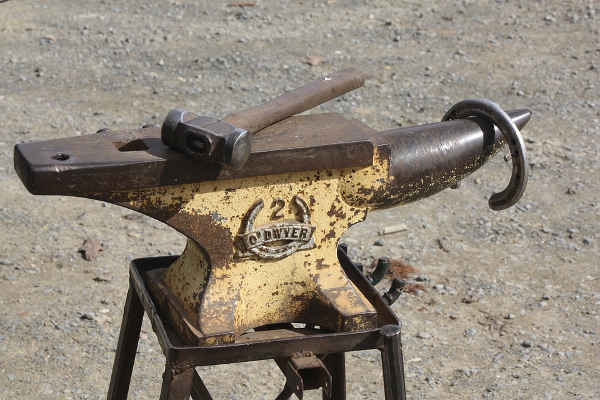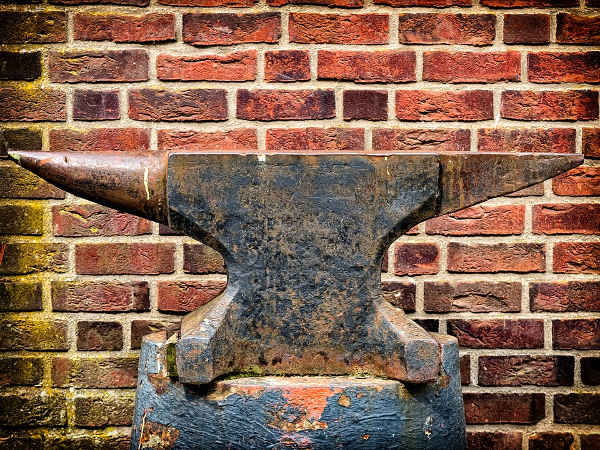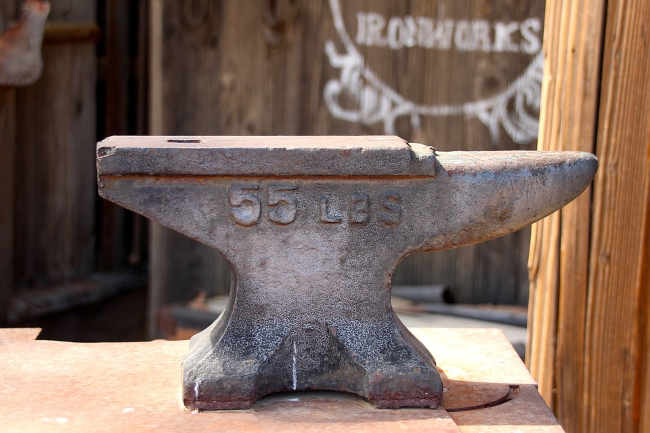So you want to buy an anvil, but you’re not sure what’s a fair price to pay. Anvil cost can vary quite a bit depending on age, size, manufacturer, and more.
How much does an anvil cost? You used to be able to buy an anvil for $1 or $2 per pound, but those days are largely gone. Now a more common price is between $3 and $6 per pound for a quality anvil. There’s a number of factors for that including a resurgence in the popularity of blacksmithing as a hobby, but mostly because of collectors.
In this article, you’ll learn how much you should pay for an anvil, what you should look for to be sure you’re getting your money’s worth, and more.
How Much Should I Pay For An Anvil?
What does a good anvil cost? If you can get an anvil for $3 to $6 per pound, you’re getting a fair deal. If you find a quality anvil for $1 or $2 per pound still, that’s a bargain.
Buying a brand new anvil will cost slightly more, usually $7 to $9 per pound.
How can I tell if I’m getting my money’s worth?
But what makes a good anvil, and what factors should you consider when looking at the price? Here are some factors that will affect anvil cost.
Edges. A good anvil has smooth edges. When you go to buy your anvil, inspect the edges for chips. You’ll still be able to work with an anvil that’s got chipped edges, but it reduces its value and means you should be able to haggle the price down a bit. Don’t be overly critical. Remember, some anvils are 100 years old so a little wear and tear is okay.
Face. The same goes for the face or the top surface of the anvil. You want to look out for deep grooves or cracks in the anvil’s face. Every time you hit your work over these spots, it will stamp those marks into your metal. If there are only a few you can work around them, but it decreases your convenience and therefore the value of the anvil.
Rebound. A quality anvil has good rebound. When you go to take a look at the anvil, bring a ball bearing along in your pocket to test it. Drop the ball bearing from about a foot and a half above the anvil’s face. When it bounces, you should be able to catch it. If it doesn’t bounce back very well, that means you’ll be using a lot more force and muscle to shape your work.
Horn. The horn of your anvil should be smooth and tapered, not flattened or distorted in any way. If an anvil has been used to cold hammer horseshoes in the past, there will normally be a flattened area near the rear of the horn.

How much should it weigh, and what style should I get?
150 pounds is a good weight for an anvil. You might want to go even bigger. That means you’ll probably end up paying around $450 to $900 for a quality anvil. Really anything you can find between 100 and 300 pounds is pretty good. You could be able to get away with a 55 lb anvil, but it gives you a lot smaller of a surface area to work with.
A farrier or German-style anvil is probably best if you have a choice of different styles. That way you’ve got a solid flat surface to work on, a horn to shape rounded work, as well as a hardy hole and pritchel hole. Very useful. You might be able to find an actual blacksmithing (or forging) anvil, although these are less common than farrier anvils.
If you’ve got a hardy tool, you can check to see that it fits in the hardy hole without too much movement. Hardy holes didn’t used to be standardized and could vary in size. Although if you’re a beginner blacksmith, this probably isn’t something you need to be worried about right away.
How Can I Tell How Much My Anvil Weighs?
The weight of your anvil will normally be stamped onto the side of it. But it’s not as easy as simply reading the number. Some anvils are made with American pounds on the side of them, but many older anvils use a British measuring system called hundredweights.
Here’s how hundredweights work… it’s a bit convoluted and weird.
The first number shown is the hundredweight. Every hundredweight is 112 lbs.
The second number is how many quarters of a hundredweight there are.
The third number is the leftover number of pounds that are too few to make up a quarter hundredweight.
Confused? That’s fair.
Here’s an example:
Your anvil has the numbers 2-3-4 stamped onto the side of it.
2 x 112 = 224 lbs
3 x (112 / 4) = 84 lbs
Then add the remaining 4 lbs
So in this case your anvil is 224 + 84 + 4 lbs, or 312 lbs in total.
How they thought this was a better system than simply writing the total number of pounds is beyond me, but that’s how it works.
The most common you’ll see is a 1 – 2 – 12, or a 180 lb anvil.
What does a blacksmith mean when they type #?
In blacksmithing forums you’ll often see people write things about their anvil weight like 100# or 300#. What does this mean?
Before # became known as a “hashtag” for my generation’s Instagram and Snapchat users, it used to be the “pound” key on a telephone. So when blacksmiths type 100#, they’re just saving themselves a few extra characters instead of typing 100lb or 100 pounds.

How To Tell An Anvil’s Quality?
Without getting into different manufacturers and brands of anvils, there are a few basic ways you can judge the quality of an anvil. Anvil cost will be affected by these qualities.
Age. Generally an older anvil is better. Old anvils were usually made with a wrought iron forged base. And had a separate tool steel surface welded on top of them. That makes your anvil stable with a springy, yet hard and durable surface.
Older anvils use more traditional weight measurements (never kilograms.) They might be thicker in the throat area, or under the horn. They also tend to have longer horns.
Place of origin. American anvils are considered to be of a lesser quality than other kinds of anvils you can buy. Most quality anvils you can buy were originally made in England (usually in Sheffield.) Some come from Germany too, but it’s more rare to find an imported German anvil.
Forged vs. cast. A forged anvil will almost always provide a better working surface for you as a blacksmith than a cast one will.
If you see seams along the base, under the horn and along the throat, then it’s a cast anvil. Manufacturer’s information will also be raised up off the anvil’s surface instead of stamped into it. Generally a cast anvil has a shorter and fatter horn that’s less useful.
The quality of cast anvils can vary a lot. Some are just as good as forged anvils, while others are extremely bad. Even a good cast anvil tends to be louder and bouncier.
Why Does An Anvil Cost So Much?
There are a few reasons.
Shipping them is a pain. Anvils weigh a lot, so they’re expensive to send whether you use regular postal service or a courier. Plus your mailman is probably going to hate you if they have to drag a 100 pound hunk of metal to your door.
Not many companies make them any more. There isn’t a booming demand for anvils, it’s a pretty niche hobby. So there aren’t many companies that find it worth their while to make, and many companies that specialized in anvils have gone out of business or changed to making something else. That means there’s a pretty low supply of anvils overall, especially quality ones. That means demand and anvil cost goes up.
They’re made of expensive raw materials. Steel is expensive. Regular cast iron is too brittle for making an anvil, and wrought iron like older anvils of made of isn’t economical today.
The process of casting steel is also a lot more work than making cast iron. It requires hotter temperatures, which makes the process more difficult and dangerous.
Many older anvils got broken or scrapped. Every year, there’s less and less old anvils in the world as they become broken, melted down to be made into other things, or just lost. So while blacksmithing is increasing in popularity, the supply of old anvils is staying the same or dropping.
Repairing old anvils is difficult, and not usually economical. So many in the past simply got scrapped or thrown away when they broke. Many anvils also got melted down for scrap during WWII.

Related Questions
Q: Can I use a regular anvil if I’m left handed?
A: Anvils are traditionally designed for right handed use. But using an anvil as a lefty isn’t really a problem. When using an anvil right-handed, your left hand normally faces the horn and your right hand faces the tail. If you’re left handed, you’ll just want to flip your anvil around the opposite way.
Q: Can I haggle my anvil price?
A: It doesn’t hurt to try. After all, most people don’t really have a use for an anvil. They’d rather get rid of it for $100 than have it sitting around for the rest of their life. So you’re not really cheating them out of anything. Especially if you’re willing to do the heavy lifting! Same reason you often see pianos available for free if you remove them, they’re a pain to deal with!
If you want to be really nice, you might offer to do some free ironwork for them once you’re a more skilled blacksmith.
Elderly people are often willing to let their stuff go if they know it’s going to be taken care of and put to good use. Don’t forget to ask for any tools they’ve got left if they actually used the anvil for blacksmithing too, you might be able to get them bundled in.

